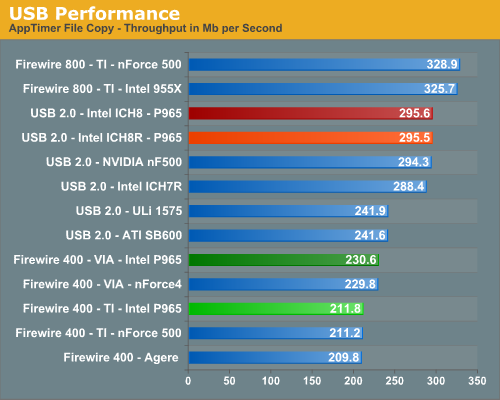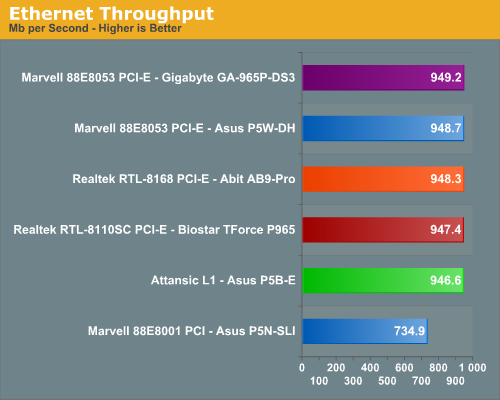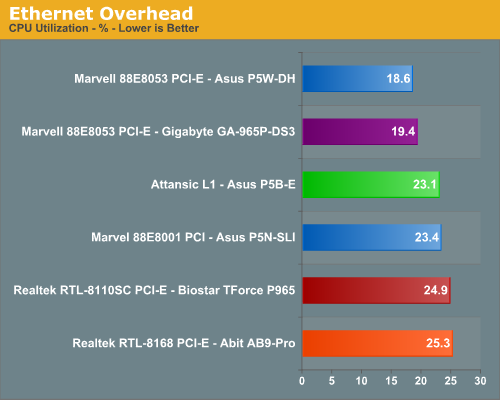Intel P965: Mid-Range Performance Sector Roundup
by Gary Key on October 20, 2006 9:00 PM EST- Posted in
- Motherboards
Firewire and USB Performance
After looking at many options for Firewire and USB testing, we finally determined that an external USB 2.0, Firewire 400, and Firewire 800 hard disk would be a sensible way to look at USB and Firewire throughput. We utilize a RAM disk as our "server", since memory removes almost all overhead from the serving end. We turn off disk caching on the USB and Firewire side by setting up the drives for "quick disconnect" so our results are consistent.
We use 2GB of system memory with timings of 3-3-3-9 and set our RAM disk to 450MB with system memory at 1550MB. Our standard file is the SPECviewPerf install file, which measures 432,533,504 bytes (412.4961MB). After copying this file to our RAM disk, we measured the time for writing from the RAM disk to our external USB 2.0, Firewire 400, or Firewire 800 drive utilizing our internal Windows based timing program. The copy times in seconds were then converted into Megabits per second (Mb) to provide a convenient means of comparing throughput. Higher Rates therefore mean better performance in this particular test.

Possibly the most interesting finding in our Firewire and USB throughput tests is the outstanding performance of an external hard drive connected to Firewire 800. Our benchmarks show Firewire 800 is up to 42% faster than a drive connected to the more common Firewire 400, and about 11% faster than the fastest USB 2.0 solution.
We see our Intel ICH8 chipset finally overtake perennial champion NVIDIA in USB 2.0 performance. We see the USB performance on the ATI SB600 still trailing the other solutions but it has vastly improved compared to the SB450. The Firewire soltuion from VIA is still slightly faster than the TI solutions normally used.
Ethernet Performance
The current motherboard test suite includes LAN performance measurements. All of these boards utilize PCI or PCI Express based controllers with the only difference being the supplier of the core logic.
The Windows 2000 Driver Development Kit (DDK) includes a useful LAN testing utility called NTttcp. We used the NTttcp tool to test Ethernet throughput and the CPU utilization of the various Ethernet Controllers used on the Intel motherboards.
We set up one machine as the server; in this test, an Intel system with an Intel CSA Gigabit LAN connection. Intel CSA has a reputation for providing fast throughput and is a logical choice for our Gigabit LAN server.
On the server side, we used the following Command Line as suggested by the VIA whitepaper on LAN testing:


The CPU utilization performance favors the Marvell Gigabit controllers with the Realtek solutions having the highest utilization numbers. The throughput numbers also favor the Marvell Gigabit controllers with the Realtek options close behind. ASUS recently switched to the Attansic L1 PCI Express based controller chip with it posting decent results in each test. We do not understand ASUS's decision to utilize a PCI based Gigabit controller on the 570SLI when the NVIDIA chipset has native support for Gigabit operations. This decision results in the worse throughput and average CPU utilization numbers. However, even with throughput at 646Mb/s it still exceeds what most home networks are capable of and certainly any DSL or Cable based Internet connection.
After looking at many options for Firewire and USB testing, we finally determined that an external USB 2.0, Firewire 400, and Firewire 800 hard disk would be a sensible way to look at USB and Firewire throughput. We utilize a RAM disk as our "server", since memory removes almost all overhead from the serving end. We turn off disk caching on the USB and Firewire side by setting up the drives for "quick disconnect" so our results are consistent.
We use 2GB of system memory with timings of 3-3-3-9 and set our RAM disk to 450MB with system memory at 1550MB. Our standard file is the SPECviewPerf install file, which measures 432,533,504 bytes (412.4961MB). After copying this file to our RAM disk, we measured the time for writing from the RAM disk to our external USB 2.0, Firewire 400, or Firewire 800 drive utilizing our internal Windows based timing program. The copy times in seconds were then converted into Megabits per second (Mb) to provide a convenient means of comparing throughput. Higher Rates therefore mean better performance in this particular test.

Possibly the most interesting finding in our Firewire and USB throughput tests is the outstanding performance of an external hard drive connected to Firewire 800. Our benchmarks show Firewire 800 is up to 42% faster than a drive connected to the more common Firewire 400, and about 11% faster than the fastest USB 2.0 solution.
We see our Intel ICH8 chipset finally overtake perennial champion NVIDIA in USB 2.0 performance. We see the USB performance on the ATI SB600 still trailing the other solutions but it has vastly improved compared to the SB450. The Firewire soltuion from VIA is still slightly faster than the TI solutions normally used.
Ethernet Performance
The current motherboard test suite includes LAN performance measurements. All of these boards utilize PCI or PCI Express based controllers with the only difference being the supplier of the core logic.
The Windows 2000 Driver Development Kit (DDK) includes a useful LAN testing utility called NTttcp. We used the NTttcp tool to test Ethernet throughput and the CPU utilization of the various Ethernet Controllers used on the Intel motherboards.
We set up one machine as the server; in this test, an Intel system with an Intel CSA Gigabit LAN connection. Intel CSA has a reputation for providing fast throughput and is a logical choice for our Gigabit LAN server.
On the server side, we used the following Command Line as suggested by the VIA whitepaper on LAN testing:
Ntttcpr -m 4,0,‹server IP› -a 4 -l 256000 -n 30000
On the client side (the motherboard under test), we used the following Command Line:Ntttcps -m 4,0,‹client IP› -a 4 -l 256000 -n 30000
At the conclusion of the test, we captured the throughput and CPU utilization figures from the client screen.

The CPU utilization performance favors the Marvell Gigabit controllers with the Realtek solutions having the highest utilization numbers. The throughput numbers also favor the Marvell Gigabit controllers with the Realtek options close behind. ASUS recently switched to the Attansic L1 PCI Express based controller chip with it posting decent results in each test. We do not understand ASUS's decision to utilize a PCI based Gigabit controller on the 570SLI when the NVIDIA chipset has native support for Gigabit operations. This decision results in the worse throughput and average CPU utilization numbers. However, even with throughput at 646Mb/s it still exceeds what most home networks are capable of and certainly any DSL or Cable based Internet connection.










62 Comments
View All Comments
powchi - Monday, October 23, 2006 - link
Thanks Jarred, lopri, Aikouka for the reply.Kougar - Saturday, October 21, 2006 - link
I am rather puzzled. As best I can tell from Google, my kit of Corsair TWIN2X2048-6400 does use Micron D9s...... but I use a Gigabyte DS3 and even with the awful release F1 BIOS onwards have had no issues using them. Currently I have a stable OC of 501FSB for a 3.5ghz rating on the old F6 BIOS. Can you confirm if this kit of RAM uses D9's or not, because I am running the 800mhz RAM at 1ghz, 2 or 2.1v only, 5-5-5-15 timings, 24 hour dual Prime stable?? I have a kit of Corsair 6400c4 on the way, so I guess this will prove interesting either way.
I would also like to clarify that with the hours upon hours I spent playing around with and overclocking the DS3, I only once experienced a situation where I had to use the BIOS jumper, as I had managed to lock it into a POST/rebooting cycle. Having only used a Abit IS7 before, I can say it was a major difference I quickly noticed.
Thanks for any info, it's appreciated. And good article, by the way!
Gary Key - Saturday, October 21, 2006 - link
Are your 6400's the 6400 plain or 6400C4? There is a difference between the IC chips used.
We have one set of Micron D9 1GB that work properly in this board but they cost about $650 right now and had a beta SPD. We do not have every D9 1GB module available for testing but the 14 we have tried resulted in failure. Some would do 445, some would do 465. Just about every DS3 owner I know has an issue with the recent D9 1G modules not reaching 500FSB at 1:1 in a stable manner. We even tried three different boards during testing. I was able to hit 510 with the 512MB D9 and some beta 1GB Elpedia sticks from OCZ. Gigabyte agrees with our findings and it should be solved shortly.
We really like the DS3, it proved to be a very stable board in testing. As I stated at the end, this board has changed our opinion about Gigabyte again.
Thanks for the comments. :)
John - Sunday, October 22, 2006 - link
Gary, have you tested G.SKILL 2GB (2 x 1GB) F2-6400PHU2-2GBHZ modules on the DS3? If not please add these to your list. This is some extremely popular Micron D9 memory with favorable reviews on Newegg and our forums.Kougar - Sunday, October 22, 2006 - link
I am currently using the basic 5-5-5-12 1.9v vanilla 6400 kit, not the 6400c3 or the 6400c4. Could you please tell me which of these uses the Micron D9s, since from what you are saying I've only found incorrect info! Thanks for fully explaining this issue with the D9's in your reply, as I did not know Anandtech had tested not one or even two but three DS3's and a whopping 14 modules! So do you know if both the "c3" and "c4" use the Micron D9s, then? I've already ordered the 6400c4 kit, so I am getting the feeling I am in for a rude surprise!
I'm grateful to know that y'all are keeping ontop of the situation, this does go a long way to explaining the extremely large disparity in user results I've read or come across about the DS3. And I'm grateful Gigabyte is working to solve this issue, the user support and countless BIOS work from them is not something I was ever expecting... it's gone a long way to putting them on my top picks list.
And I believe I should be thanking you for the reply. ;)
jonp - Saturday, October 21, 2006 - link
-- on the second memory chart it always says "4/4 slots populated - 1 Dual-Channel Bank". If all four slots are populated with the same memory, why does it say "1" Dual-Channel Bank?-- I can only find the GEIL memory at one on-line merchant (via froogle or pricewatch) at $460 for 2GB. That would be $920 for 4GB! it would have been nice if you had also picked a less expensive memory that more of us could afford.
-- ASUS making a significant change to their product and only changing the version makes it VERY hard (impossible) to on-line order the specific product desired. newegg says order and if wrong, they will exchange...but that gets expensive too... and takes at least 7 days turnaround; and no guarantee that it will be the right one even then.
thanks for the article...it was, as always, full of useful data and observations.
Gary Key - Saturday, October 21, 2006 - link
1. The charts have been corrected. I stated this above but Jarred and I were editing at the same time on some pages and we did an overwrite on each other's corrections a couple of times. We learned our lesson after the Biostar section turned into the ASUS section. ;-)2. When we started this article the GEIL and G.Skill PC2-6400 that we used was in the $269~$289 range for a 2GB kit. This was far below the $500+ prices that our OCZ and Corsair memory modules had reached at that time. I am trying to create a memory table at this time as the boards were tested with everything from A-Data DDR2-533 to OCZ PC2-8000VX2. Our intentions were to use mid-range PC2-6400 memory when we started but it appears we chose some memory that is in very high demand and short supply now.
3. As I stated in the article, ASUS will probably call the 1.02G board something else. The 1.01G board is not a slacker. :)
Thank you for the comments, we appreciate them.
Aikouka - Saturday, October 21, 2006 - link
After going through about 4 or so of the motherboards and looking at their windows programs... I just gotta rant.Why in God's name must motherboard manufacturers make their programs SO UGLY? I'm no Martha Stewart, but even I can see that those programs are attrocious to look at and I actually don't install those cheesy programs because of how horrible they look. I prefer a normal streamlined windows look to my programs, hence why I use the Windows Classic theme. But even if your preference isn't a normal streamlined windows look, I don't see how anyone could find those horrid looking things called applications desirable.
Nakazato - Saturday, October 21, 2006 - link
it's Taiwanese tradition. For the people above... the S3 does not overclock as well as the DS3, it's very noticable. The DQ6 is in theory better than the DS3, but may hardly be noticable and when it is, it's probably just luck of the draw.My only criticism of the review is that only one memory module type was used and that I know other reviews on AT have included some other comparisons... but your review is more recent with more of the facts in(so more relevant). I know you had some references in the article and I know that the Micron chips are the best on average, but on occasion some chips perform better on a per board basis and not just on a per chipset basis.
Review does get 2 thumbs up from me though. The extra side information(EAX2 Support of onboard sound drivers, Micron D9 chips not fully supported, but will be, etc) helps make buying decisions. Thanks for the article!
Aikouka - Sunday, October 22, 2006 - link
Gah, how can such an ugly thing be tradition. It honestly detracts from the overall computing experience having something so tastelessly crafted. I guess to each his own :/